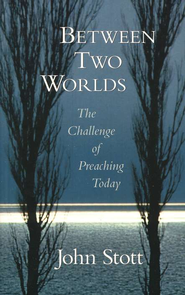Between Two Worlds the Art of Preaching in the Twentieth Century by John Stott

This book review of John Stott's Between Two Worldswas written every bit office of Pastor Lane'southward doctoral class work, and as such, it is written in a more formal, academic tone than the residuum of this blog'southward posts. Nonetheless, nosotros hope the audience volition find these bookish book reviews useful, which is why we take published them for your reference.
John R. W. Stott was born in London to Sir Arnold and Emily Stott. His male parent was a leading dr. and an agnostic. His mother was Lutheran in the Church of England. He studied mod languages at Trinity Higher, Cambridge, and went on to graduate with a degree in French and theology. Ordained in 1945, he became a curate at All Souls Church building from 1945-1950, and so rector 1950-1975. He grew upwardly in this church and spent about his whole life there, apart from a few years in Cambridge. He rose to national and international influence, and most notably in the dispute near evangelicals remaining in the Church of England, a fence that arose when he opposed Dr. Martin Lloyd-Jones call to leave the liberal churches. In 1975 he resigned as Rector of All Souls Church to focus on other projects. He remained at the church and was appointed Rector Emeritus. He retired in 2007 at the age of 86. He passed away on July 27, 2011, with family standing around his bed reading the Bible and listening to Handel'southward Messiah. He remained celibate all his entire life. Christianity Today described him equally "An architect of 20th century evangelicalism who shaped the religion of a generation." At his expiry, which was reported in the secular media, the British Dissemination Corporation described him as ane who "could explain complex theology in a way lay people could easily empathise." Upon his death, memorial services were held, in addition to the i at All Souls Church, at locations in London, New Zealand, Wheaton, Illinois, and Toronto, Canada. He was an evangelical of the highest gild.

Between Two Worlds makes a significant contribution to the bailiwick and study of preaching in a number of ways. Starting time, the historical sketch that begins the book is an exceptional overview that is beneficial and insightful. Second, the author speaks from a long tenure of faithfulness in the preaching ministry building. The volume is seasoned with counsel and wisdom from one who has excelled in the arts and crafts of preaching and stands as a model scholar and theologian. Third, the amount of information from quotations and references is astounding. A wealth of data is compiled in this piece of work that stands every bit resource for greater study. At that place are 499 references in eight chapters, for an average of 62 per chapter. One affiliate has 101 notes. A lengthier consideration of this book by greater exploration of notes would prove greatly beneficial.
The general nature of this book is foundational, from theology and history, in demonstrating the thread of the preaching tradition, but inherent is likewise a stiff philosophical mandate that the author puts frontward for preaching and the role is serves. Though there is some technical data included, really more than "what to practise" rather than "how-to," this is non the principal focus of the book.
"The Celebrity of Preaching: A Historical Sketch" is a thousand thread that begins with the argument "preaching is central and distinctive to Christianity," and demonstrates the historical presence and importance of preaching, beginning with Jesus, the Apostles and early church fathers and following through every major flow of history to the twentieth century. This affiliate is a valuable resource that culminates a swell amount of information for study and resources, seventy-three endnotes in this chapter lonely, and helpful for any person seeking deeper written report.
"Contemporary Objections to Preaching" addresses modern resistance to the office of preaching in iii wide categories: the anti-authority mood, the cybernetics revolution, and the Church's loss of conviction in the gospel. With each category the author offers an advisable Christian response with guided counsel that helps ane to rise higher up the upshot and work to address it. There is a real sense of calm, seasoned wisdom in these pages that helps one not to overreact, simply encourages strong biblical response. It would be all-time if the proponents of dialogical preaching would read and heed his words that the nature of the sermon is inherently dialogical, not that the course should be structured such a style.
"Theological Foundations for Preaching" establishes an "indispensible necessity, for the celebrity of God and the food of the church, of conscientious biblical preaching" through 5 theological arguments: a conviction about God, about scripture, nigh the Church, about the pastorate, and almost preaching. Between theological foundations and historical examples of how preachers throughout the ages were affected past these, he provides a compelling motivation that leaves one with picayune other than burn to preach as a mandate form God.
"Preaching as Span-building" is a chapter of particular interest to the author, equally noted in the Introduction. This affiliate compels the nature of our sermons to cantankerous into culture and speak to the people of our times with the singular field of study of Christ, "the fulfillment of every truthful homo aspiration." He appeals to biblical and historical precedents as well as the importance of personal Christian ethics and broader social and political issues. He even addresses our treatment of difficult, controversial questions and gives sound, Christ-specific counsel. This chapter is a wealth of resource and encouragement for anyone who takes serious their responsibleness to be faithful to Scripture, preaching Christ with a 18-carat center of compassion for people and the globe.
"The Call to Study" begins the first of two nearly applied chapters that address not so much the "how-to" of sermon preparation, but rather the "what to exercise" to set a sermon. This emphasis is demonstrated by describing, more than telling, what we practise. He states that our study must be comprehensive, open-minded, and expectant. He also includes, what some would disagree with, our demand to study the world around us forth with the Bible, stating that a preacher must know his people. Preacher must ask questions and larn from their people. As well, he recommends a report grouping with other pastors to enrich and strengthen 1'due south agreement and application. He likewise addresses some hindrances to the preachers study. This chapter, though not a textbook on sermon grooming, is an excellent resources of ideas and guidance that approaches this thing from a unique perspective.
"Preparing Sermons" is the most instructive of the chapters, but still not highly technical in nature. His recommendations for choosing a passage are a chip unlike in that he does not brand a strong case for preaching through books of the Bible, though he does practice it. As well, though he describes expositional preaching, he does so in much hypernym, avoiding more rigorous technical details. And, though describing much the same process, this is very different than many more modernistic texts of expository preaching.
"Sincerity and Earnestness" is best described by simply proverb that the preacher must mean what he says and live what he preaches. This is to say "the practice of preaching cannot be divorced from the person of the preacher." How the preacher presents himself, and all the many issues involved, are mostly covered here. How important this chapter is at a time when too many preachers have become professionals, divorcing their work form their life. More than but the impact it has on others when sin is revealed in the life of a preacher, is the preacher who remains and continues to preach without any power.
"Courage and Humility" brings a great decision to this book. In truthful form with the book, he begins with biblical and historical examples to introduce. Most important, he explains why backbone and humility are important by listing the need to comfort and disturb and the demand to practice systematic exposition for our own discipline. He finishes by exploring the value of humility — the "chief occupational take chances" for the preacher — and how it prepares them to be fully used of God. Humility saves the preacher from being neither closed or disquisitional, helps to avoid adding to or taking abroad from scripture, ameliorate ensures pure motives, and keeps ane dependent on Holy Spirit's power. This chapter is a great conclusion that leaves the reader in a proper place earlier God to end a classic work.
Dr. Stott'south writing style is evidently and straightforward, making it very readable. The manner in which the material is organized also makes information technology easy to run across and accessible in review. He incorporates a great corporeality of material, but it does not feel ho-hum or burdensome in reading. Rather, it broadens the perspective of the point he is making.
I am about enthusiastic about 3 aspects of this book. Get-go, the historical sketch is great. Information technology whets the appetite for further study and research. Second, his treatment of the objections to preaching could not be more than advisable for the twenty-four hour period and fourth dimension in which we live. Considering when he wrote the volume, 1982, the 30 years that accept since ensued accept only bred greater expressions of this same resistance. This message must exist renewed in the church today to counter the poor expressions that are now being propagated and offered every bit substitutes. Third, the bridge-building aspect of preaching becomes a greater necessity every day. The pulpit must speak to the issues of the day with the gospel. This chapter gives cracking principles and counsel for a preacher to create a discernment paradigm to think through how best to accost current issues that arise from God'due south Word.
More volume reviews by Pastor Lane
- Ability in the Pulpit
- Text-Driven Preaching: God'southward Word at the Heart of Every Sermon
- The Passion Driven Sermon: Irresolute the Mode PastorsPreach and Congregations Listen
- Preparing Expository Sermons
Source: http://mlaneharrison.com/2012/09/between-two-worlds-the-art-of-preaching-in-the-twentieth-century/
0 Response to "Between Two Worlds the Art of Preaching in the Twentieth Century by John Stott"
Post a Comment